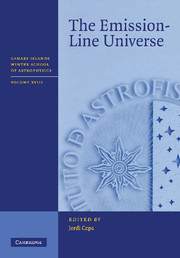Book contents
- Frontmatter
- Contents
- List of contributors
- List of participants
- Preface
- Acknowledgements
- 1 What can emission lines tell us?
- 2 The observer's perspective: Emission-line surveys
- 3 The astrophysics of early galaxy formation
- 4 Primeval galaxies
- 5 Active galactic nuclei
- 6 Chemical evolution
- 7 Galactic sources of emission lines
- 8 Narrow-band imaging
- 9 Long-slit spectroscopy
- 10 Basic principles of tunable filters
8 - Narrow-band imaging
Published online by Cambridge University Press: 23 November 2009
- Frontmatter
- Contents
- List of contributors
- List of participants
- Preface
- Acknowledgements
- 1 What can emission lines tell us?
- 2 The observer's perspective: Emission-line surveys
- 3 The astrophysics of early galaxy formation
- 4 Primeval galaxies
- 5 Active galactic nuclei
- 6 Chemical evolution
- 7 Galactic sources of emission lines
- 8 Narrow-band imaging
- 9 Long-slit spectroscopy
- 10 Basic principles of tunable filters
Summary
Introduction
The imaging method which uses narrow-band filters is the first and most direct way to obtain information about the emission lines. In contrast to broad-band photometry, in which several emission lines are integrated within one filter, the narrow-band filters are designed to transmit only one emission line (in ideal cases).
This method has considerable advantages over spectroscopic methods: we are able to obtain spatial resolution, i.e. several objects fit in only one exposure frame; the required time for an observation run is shortened; and lastly, the observation procedures and reduction are less complicated than those of a spectroscopic survey. Usually during a run information for only a few lines (three or four at best) can be obtained, in contrast to the full spectrum obtained in spectroscopy: see, for example, the works of Belley & Roy (1992), where hundreds of HII regions are presented with fluxes in three emission lines using direct imaging, and van Zee et al. (1998), with only about a dozen HII regions in ten different emission lines employing optical spectroscopy.
Narrow-band imaging is a powerful tool for characterizing the physical properties of the star-forming regions in nearby galaxies. With a few lines, we are able to determine, for example, the abundance, temperature, or initial mass function of the ionizing stars, thus obtaining clues to the physical processes that occur in the core of the HII regions; see, for example, Cedrés & Cepa (2002). This can be seen in Figure 8.1, where the composite broad-band image (with the B, R, and K bands) and an Hα image of the galaxy UCM 2325+2318 can be compared. The star-forming regions are clearly defined in the narrow-band image.
- Type
- Chapter
- Information
- The Emission-Line Universe , pp. 262 - 273Publisher: Cambridge University PressPrint publication year: 2008



